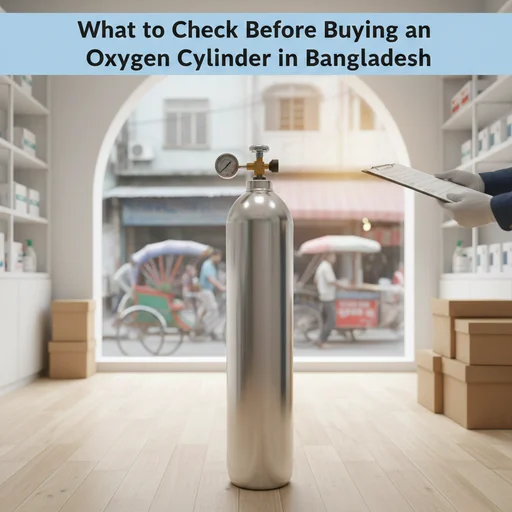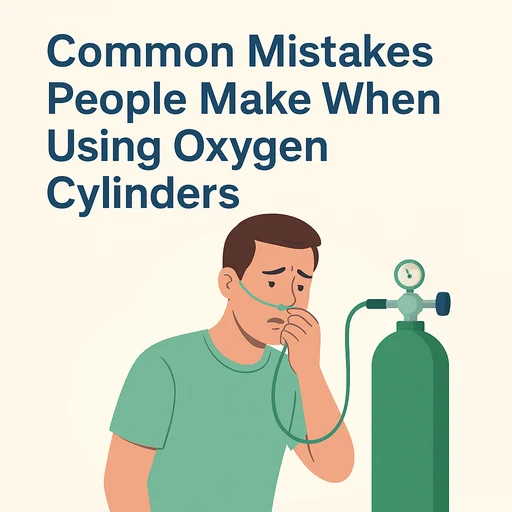Breathing shouldn’t be a luxury. Yet for millions of people worldwide, every breath is a conscious effort… a reminder that their lungs aren’t working the way they should.
This is where oxygen cylinders become more than just medical equipment. They become lifelines.
If you or someone you know struggles with breathing, understanding when oxygen therapy is needed can make all the difference. Let’s talk about the medical conditions and situations that require oxygen support, and why this treatment matters so much.
Understanding Oxygen Therapy: Why It Matters
Your body runs on oxygen. Every cell, every organ, every function depends on getting enough of it. When oxygen levels drop too low (a condition called hypoxemia), your body can’t function properly.
Oxygen therapy helps people with COPD, COVID-19, emphysema, sleep apnea, and other breathing problems get enough oxygen to function and stay well. Think of it as supplemental support… like glasses for your lungs.
The treatment itself is straightforward. Oxygen is delivered through a nasal tube or mask, allowing you to breathe in higher concentrations than what’s naturally available in room air (which contains about 21% oxygen).
Chronic Respiratory Diseases That Need Oxygen Support
COPD: The Leading Cause
Chronic obstructive pulmonary disease affects millions of people, especially older adults and former smokers. The disease includes chronic bronchitis and emphysema, conditions in which the airways narrow and lung tissue is damaged over time.
People with COPD often can’t get enough oxygen on their own. Some people with chronic conditions need supplemental oxygen for life, while others need it temporarily until they recover from an acute (short-term) illness.
If you have severe COPD, you might need oxygen therapy 24 hours a day. Others only need it during physical activity or sleep. The goal is to keep your blood oxygen levels stable so your organs can function normally.
For those in Dhaka looking for reliable oxygen support, Marium Oxygen provides fast delivery and 24/7 customer support. We offer oxygen cylinders for purchase, rent, and refill options.
Asthma: When Airways Tighten
Asthma causes your airways to become inflamed and narrow, making breathing difficult. During an asthma attack, oxygen levels can drop quickly. You might experience wheezing, shortness of breath, and chest tightness.
Emergency oxygen therapy during an attack can be literally life-saving. It helps restore normal oxygen saturation levels while other medications work to open up your airways.
Cystic Fibrosis: A Genetic Challenge
This inherited disorder causes thick, sticky mucus to build up in the lungs. The mucus clogs the airways and traps bacteria, leading to recurrent infections and breathing difficulties.
People with cystic fibrosis often need oxygen therapy to compensate for their impaired lung function. The supplemental oxygen ensures their bodies get what they need, even when their lungs can’t deliver it efficiently.
Lung Infections That Demand Oxygen
Pneumonia: When Lungs Fill With Fluid
Pneumonia is a lung infection that causes inflammation and fluid buildup in the air sacs of the lungs. This makes it hard for oxygen to pass from your lungs into your bloodstream.
Moderate levels of supplemental oxygen (nasal cannulae at 2 to 6 l/min or simple mask at 5 to 10 l/min unless otherwise stated) are required if the patient with pneumonia is hypoxaemic. The initial oxygen saturation target range is 94% to 98%.
The treatment helps your body heal by ensuring adequate oxygenation while antibiotics fight the infection. Many patients need oxygen for several days until their lungs recover.
COVID-19 and Other Viral Infections
The COVID-19 pandemic showed us just how critical oxygen therapy can be. Severe cases often cause significant lung damage, leaving patients unable to breathe adequately on their own.
If you were sick with pneumonia or COVID-19, you may need supplemental oxygen for 3 to 6 months, until your lungs heal.
Some patients need oxygen concentrators at home during recovery. These devices pull oxygen from the air and deliver it at higher concentrations, providing continuous support during healing.
Heart-Related Conditions Requiring Oxygen
Congestive Heart Failure: When the Heart Can’t Keep Up
In heart failure, your heart struggles to pump blood effectively. This leads to fluid buildup in the lungs and reduced oxygen delivery to the rest of your body.
Patients may also require additional oxygen during acute exacerbations. Oxygen therapy relieves the strain on your heart and ensures vital organs receive adequate oxygen.
Many patients with chronic heart failure need long-term oxygen support at home. This might mean having an oxygen cylinder ready for emergencies or daily use.
Pulmonary Hypertension: High Pressure in Lung Arteries
This condition involves elevated blood pressure in the arteries that carry blood to your lungs. It makes your heart work harder and can lead to right-sided heart failure.
You may qualify for home oxygen therapy if you have symptoms and/or findings related to low oxygen levels, such as pulmonary hypertension or recurring congestive heart failure due to right-sided heart failure.
Oxygen therapy helps reduce the workload on your heart and improves your ability to stay active.
Emergency Situations That Need Immediate Oxygen
Cardiac Arrest: Every Second Counts
When someone’s heart stops beating, oxygen delivery to the brain stops too. Brain damage can begin within minutes.
Oxygen therapy is a vital component of post-resuscitation care. The hypoxic nature of cardiac arrest requires a maximal dose of oxygen during resuscitation.
Emergency responders use oxygen immediately during CPR and after restoring the heartbeat. This prevents brain damage and supports recovery.
In Bangladesh, having quick access to emergency oxygen can save lives. At Marium Oxygen, we provide 60-minute delivery inside Dhaka city and 24/7 emergency support. Our team helps with installation, so you’re never alone when you need help.
Severe Trauma and Blood Loss
Major injuries can lead to shock, a condition where your body can’t deliver enough oxygen to tissues. Trauma patients often need high-flow oxygen to maintain organ function while doctors address the underlying injuries.
The same goes for severe blood loss. When you lose blood, you lose the red blood cells that carry oxygen. Supplemental oxygen helps compensate until the situation stabilizes.
Respiratory Failure: When Breathing Stops Working
Respiratory failure means your lungs can’t properly exchange oxygen and carbon dioxide. This can happen suddenly (acute) or develop over time (chronic).
Acute respiratory failure is a medical emergency. It requires immediate oxygen therapy, often delivered through CPAP machines or mechanical ventilation in severe cases.
Sleep-Related Breathing Disorders
Sleep Apnea: Breathing Stops During Sleep
Sleep apnea causes repeated pauses in breathing throughout the night. Each time your breathing stops, your oxygen levels drop.
Sleep apnea often requires treatment with CPAP therapy, which keeps airways open. Some people also need supplemental oxygen to maintain proper levels during sleep.
Many patients use both a CPAP machine and oxygen therapy together. This combination ensures continuous breathing and adequate oxygenation throughout the night.
Nocturnal Hypoxemia: Low Oxygen While Sleeping
Some conditions cause oxygen levels to drop, specifically during sleep, even without sleep apnea. This includes advanced lung disease, obesity hypoventilation syndrome, and neuromuscular disorders.
Nighttime oxygen therapy can dramatically improve sleep quality and morning energy levels. When your body gets adequate oxygen during sleep, you wake up feeling more rested.
Surgical Procedures and Anesthesia
Surgery requires anesthesia to keep you unconscious and pain-free. But anesthesia also slows your breathing rate.
You may also need oxygen therapy for life or temporarily. During and after surgery, oxygen cylinders help maintain proper oxygen levels until the anesthesia wears off completely.
Recovery rooms in hospitals keep oxygen readily available for every patient. This ensures safe recovery from surgical procedures.
How to Know If You Need Oxygen Therapy
Your doctor will determine if you need oxygen based on several factors:
Blood oxygen levels: Measured using a pulse oximeter or blood gas test. Normal levels are typically 95% or above. A resting PaO2 = 7.3 kPa (55 mm Hg) or SaO2 88% or less while being at rest in a stable clinical condition often indicates the need for oxygen therapy.
Physical symptoms: Shortness of breath, confusion, fatigue, rapid heartbeat, or bluish skin color all suggest low oxygen levels.
Activity limitations: If you can’t walk, climb stairs, or do daily activities without becoming breathless, oxygen therapy might help.
Existing medical conditions: Chronic lung or heart disease increases the likelihood you’ll need supplemental oxygen at some point.
Getting Oxygen Therapy at Home
If you need long-term oxygen therapy, you’ll likely use equipment at home. Options include:
Oxygen cylinders: Portable and reliable for short-term or emergency use. You can purchase, rent, or refill them as needed.
Oxygen concentrators: Plug-in devices that pull oxygen from the air. Good for continuous home use.
Portable systems: Smaller units you can carry for mobility outside your home.
At Marium Oxygen, we’re a government-approved oxygen supplier serving the Dhaka division. We offer free installation help, cash on delivery, and 24/7 support. Our delivery partners ensure you understand how to use your equipment safely and effectively.
We also provide other essential medical equipment, including hospital beds, wheelchairs, nebulizer machines, and suction machines for comprehensive home care needs.
Living Well With Oxygen Therapy
The thought of needing oxygen can feel overwhelming at first. But the reality is that oxygen therapy gives people their lives back.
The best thing is that many patients will feel a little or a lot more energy. They’ll be able to walk further. They’ll be able to accomplish their activities of daily living with more ease.
You can exercise again, sleep better, think more clearly, and participate in activities you’d given up. Low oxygen levels affect every part of your body. When you correct that, everything improves.
Studies show you need to use oxygen for at least 18 hours daily to get maximum benefits. But even that schedule allows time for showers and other brief activities without oxygen, if you can tolerate it.
Safety Matters
Oxygen is generally safe when used correctly, but you need to follow some important rules:
Never smoke or use flammable materials near oxygen. Oxygen supports combustion and creates serious fire risks.
Keep cylinders secured and upright. A falling cylinder can become dangerous if it’s damaged.
Follow your prescribed flow rate. Too much oxygen can actually cause problems, including oxygen toxicity.
Clean your equipment regularly to prevent infections.
The Truth Is
Oxygen cylinders and oxygen therapy aren’t just medical treatments. They’re tools that help people breathe easier, live longer, and enjoy a better quality of life.
Whether you have COPD, heart failure, sleep apnea, or are recovering from pneumonia or surgery, oxygen therapy can make a real difference. The key is recognizing when you need it and getting proper support from healthcare providers and reliable suppliers.
If you’re experiencing breathing difficulties, talk to your doctor about whether oxygen therapy might help. And if you’re in Dhaka, remember that Marium Oxygen is here to support you with quality equipment, fast delivery, and round-the-clock assistance.
Because everyone deserves to breathe freely.













